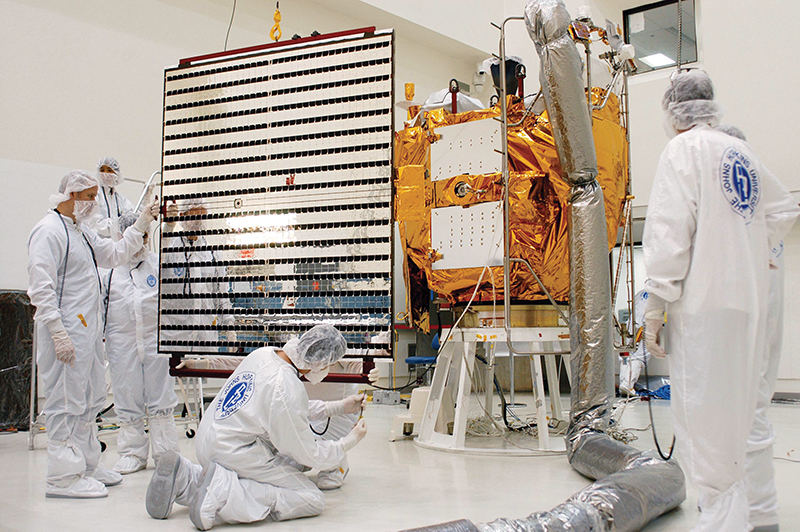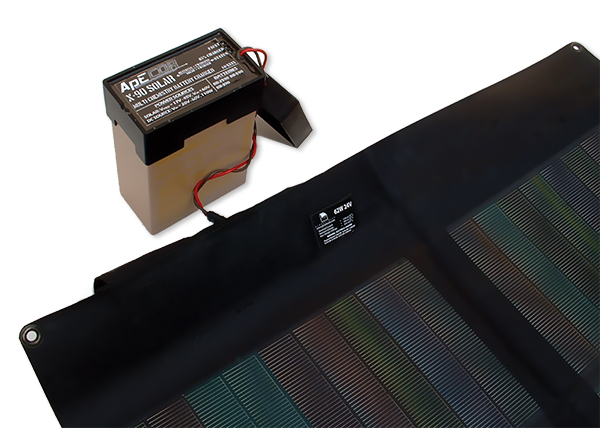
Control Algorithms Charge Batteries Faster
NASA Technology
On March 29, 2011, NASA’s Mercury Surface, Space Environment, Geochemistry and Ranging (MESSENGER) spacecraft beamed a milestone image to Earth: the first photo of Mercury taken from orbit around the solar system’s innermost planet. (MESSENGER is also the first spacecraft to orbit Mercury.) Like most of NASA’s deep space probes, MESSENGER is enabled by a complex power system that allows its science instruments and communications to function continuously as it travels millions of miles from Earth.
“Typically, there isn’t one particular power source that can support the entire mission,” says Linda Taylor, electrical engineer in Glenn Research Center’s Power Systems Analysis Branch. “If you have solar arrays and you are in orbit, at some point you’re going to be in eclipse.” Because of this, Taylor explains, spacecraft like MESSENGER feature hybrid power systems. MESSENGER is powered by a two-panel solar array coupled with a nickel hydrogen battery. The solar arrays provide energy to the probe and charge the battery; when the spacecraft’s orbit carries it behind Mercury and out of the Sun’s light, the spacecraft switches to battery power to continue operations.
Typically, hybrid systems with multiple power inputs and a battery acting alternately as storage and a power source require multiple converters to handle the power flow between the devices, Taylor says. (Power converters change the qualities of electrical energy, such as from alternating current to direct current, or between different levels of voltage or frequency.) This contributes to a pair of major concerns for spacecraft design.
“Weight and size are big drivers for any space application,” Taylor says, noting that every pound added to a space vehicle incurs significant costs. For an innovative solution to managing power flows in a lightweight, cost-effective manner, NASA turned to a private industry partner.
Partnership
Through Small Business Innovation Research (SBIR) contracts with Glenn, Advanced Power Electronics Corporation (ApECOR) of Orlando, Florida, devised a three-port power converter for space systems. Much like a traffic cop at an intersection, the converter directs the flow and levels of electricity collected from solar panels, shunting part of that power into storage batteries, and pulling it out of the batteries to provide energy when solar panels are ineffective.
“The control strategy becomes fairly complicated when you have multiple interfaces to the same converter,” says John Elmes, vice president of advanced technology for ApECOR. “The challenge is that you have so many conflicting control parameters, you have to figure out a way to simultaneously operate them.”
For the NASA project, ApECOR developed complex control algorithms for managing the power flows through a single device that has the potential to directly minimize the size and weight of overall spacecraft power systems. Taylor has used the SBIR-derived device for testing at Glenn and hopes to incorporate it into the Orion Crew Module test bed at the Center. In the meantime, ApECOR has applied the control algorithms it developed for the SBIR project to a new commercial product.
Benefits
ApECOR’s X-90 Solar Charger is capable of using a wide range of solar arrays or other DC sources to replenish portable rechargeable batteries. Plugging directly on top of compatible batteries and requiring only the wiring needed to link to the power source, the device makes use of Maximum Power Point Tracking (MPPT) technology to ensure it gathers the most energy possible from a connected solar panel. Solar panel output varies depending on the amount of light and other environmental conditions; MPPT constantly changes the operation of the panel to maximize its efficiency. ApECOR incorporated MPPT into the three-port converter it created for NASA, which in turn provided the company with the capability to add the feature to the X-90.
“We were able to use what we learned from the NASA three-port converter work and use it to help implement our battery charge algorithms on the X-90 while also implementing MPPT on the solar panel,” Elmes says. The result, he says, is ApECOR’s product charges batteries at least 30 percent faster than comparative devices using the same solar panel. This kind of speed is a particular advantage for one of ApECOR’s target customers, the military, providing a means of quickly and efficiently charging the batteries used for radios and other devices in the field.
Elmes says the NASA-derived X-90 is a promising addition to ApECOR’s offerings, and that other potential applications for the technology include providing power through solar or wind sources in rural farming areas in developing countries and allowing for the remote operation of irrigation pumps. The company is also engaged in another SBIR project with Glenn, working to develop high temperature semiconductors for applications in space, where extreme temperatures are the norm. This project could result in numerous terrestrial uses related to eliminating the problem of heat generated by powerful electronics—using temperature-tolerant semiconductors, costly and space-consuming elements like heat sinks and liquid coolant systems could be downsized or eliminated.
“It’s hard for small businesses to pursue work like this that could have a major economic benefit down the road but is currently risky and difficult,” Elmes says. “The combination at NASA, where they have a very strong team of people who understand where the technology is going and can see where there are technological needs, provides a big benefit.

ApECOR’s X-90 Solar Charger uses the company’s NASA-derived control algorithms to efficiently charge batteries from solar or other sources.

Technicians secure guide wires to one of MESSENGER’s two solar panels. The panels combine with a nickel hydrogen battery to power the spacecraft.













